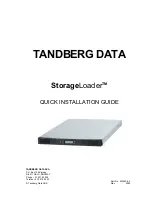
Tandberg Data
StorageLoader
Step 4. Removing the Transport Lock
The robot mechanism is
protected from damage
during shipment with a
screw holding the robotics
in a locked position.
This locking screw is
marked with a red plastic
tab protruding between the
right magazine and the
front panel assembly.
This locking screw must
be removed before the
StorageLoader can
operate normally.
Figure 10. Magazine lock marked with red plastic tab
The locking screw will be detected when the StorageLoader is powered on. The
display will show a message indicating the locking screw has been detected. The
display will instruct the user to remove the magazine to gain access to the locking
screw. Remove the screw and reinsert the magazine. The loader will now continue
its power on sequence, see next step.
Note: Keep the screw in a safe place. You will need it to lock the robot if you need
to return your StorageLoader to the supplier for service or repair.
Important:
The warranty does not cover damage to the loader, shipped without the
locking screw properly installed.
Step 5. Running Power-On Selftest
After the transport lock is removed, the loader will continue running it’s power-on
selftest and doing an inventory of its cartridges.
The word Idle and the cartridge map will appear on the default display screen. If the
self-diagnostics and the inventory sequence are successfully completed, the green
LED will illuminate. The StorageLoader is now ready to be installed in the system.
If a problem occurs during the power-on sequence, the StorageLoader will display
an error message on the display.
Step 6. Setting the SCSI Address
There is a LCD display on the front panel, and four control buttons. After the
Power-on sequence is finished, select Menu and scroll down until you can select
Setup. Then you scroll down until the display look like the figure below, and you
select SCSI setup.
StorageLoader Quick Installation Guide
11















